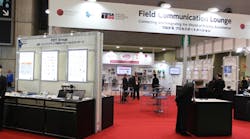The General Assembly was held in conjunction with the Measurement and Control (JEMIMA) show, organized by the Japan Electric Measuring Instruments Manufacturers' Association. Measurement & Control is the largest automation industry gathering in Japan. Among the key highlights of this year's exhibition were evolving solutions for "connectivity" and the changing the face of the measurement and control business to meet evolving customer needs.
As FieldComm Group's first annual global meeting (the organization was formed last year through the combining of the Fieldbus Foundation and HART Communication Foundation), the General Assembly provided an update on FOUNDATION™ Fieldbus, HART®, HART-IP™ and WirelessHART® technologies, as well as Field Device Integration (FDI®). It also included presentations by leading manufacturers and other industrial firms that have installed these solutions in their operations.
FieldComm Group President and CEO Ted Masters commented, "FieldComm Group's inaugural General Assembly was a major success. We were very pleased with the large turnout of industrial firms from across the Asia-Pacific region, and appreciated the valuable contributions made by presenters, sponsors and other stakeholders interested in the future of process automation."
Masters added, "Our 2015 General Assembly highlighted the advantages of FieldComm Group technologies for optimizing plant productivity, improving asset management and reliability, and reducing capital and operating costs. These technologies are advancing to keep pace with the demands of the process industries."
Staged by the FieldComm Group Asia-Pacific Organization, an end user forum and technology display attracting several hundred participants offered an opportunity to share best practices for FOUNDATION Fieldbus and HART installations. Presentations focused on strategies for realizing more value from the data these protocols enable to improve the performance of process operations. Attendees also had an opportunity to view products and solutions from leading automation suppliers.
End user forum presenters included: John Rezabek, Ashland Chemical ("Internet of Things for Process Control"), Satoru Nunokawa, Mitsubishi Chemical Holding Group ("Field Intelligence in the Chemical Industry"), and Rong Gul, Shell Global Solutions ("Improved Commissioning Procedures at Shell Support On-going Proactive Maintenance").
According to Rezabek, the process industries have had "intelligent" devices and methods to monitor them for near 20 years, and yet, users are challenged to discern useful information. "'Big Data' can lend some valuable insights, but human know-how, thoughts and experience are still essential," he said. "Increasingly capable networks and services are critical, but standards to channel their application for process control are also a must."
Rezabek noted that companies involved with FieldComm Group technologies are supporters of open standards that serve the priorities of "real" end users, including plant operators, process specialists, company management and the enterprise.
Nunokawa examined the challenges faced by hydrocarbon processing firms to become more agile and implement "made-to-order" manufacturing business models in a competitive business environment. In his view, petroleum producers are dealing with increasing complexity in production and enterprise management, rising safety and security concerns, human resource issues, diversified asset portfolios, and growing data overflow.
Nunokawa believes greater utilization of field intelligence through digital device protocols and the IIoT will provide significant benefits throughout the automation lifecycle. In addition to improved process stability and safety, these include CAPEX and OPEX savings through reductions in cabinets, cable and devices; easier engineering; enhanced factory and site acceptance testing; improved operator performance; decreased downtime; and improved asset management.
Gul's presentation outlined Shell's experiences with its Prelude floating liquefied natural gas (FLNG) facility, which will produce approximately 3.6 million tons of liquefied natural gas (LNG) per year. He explained how commissioning a project with thousands of devices to enable a proactive maintenance strategy presents enormous hurdles for an operating company.
In particular, Gul described the use of a configuration reporting tool to efficiently verify the configuration of devices per project specifications. The tool allowed Shell personnel to check the configurations of multiple devices and quickly identify incorrect settings for QA/QC on the Prelude FLNG project.
The end user forum concluded with a question and answer session with the speaker panel.
A key feature of the General Assembly-related activities was a live demonstration of FieldComm Group technologies as part of a "Field Communication Lounge" within the Measurement and Control show at the Tokyo International Exhibition Center. The lounge created a single exhibit area for visitors to learn about and experience the latest in field communication and integration technologies, and discuss how they are used to deliver results that can improve a company's profitability.
Based on the theme "CONNECT+INTEGRATE=VALUE," FieldComm Group's multi-vendor technology wall included leading control system suppliers and a wide range of field instrumentation. The interactive exhibit showed how digital integration enables industrial organizations to use actionable intelligence to enhance decision-making, and thus achieve significant operational and business benefits.
The display demonstrated the multiple ways end users can connect to valuable information in intelligent field devices—regardless of protocol—by using FDI to integrate the information in a control system, asset management application or enterprise resource planning (ERP) system; then visualize and evaluate the data; and ultimately take action based on the information to prevent shutdowns, lower operating costs, reduce maintenance expenses, and become more predictive in how plants are run.
For more information, please visit the FieldComm Group website.




